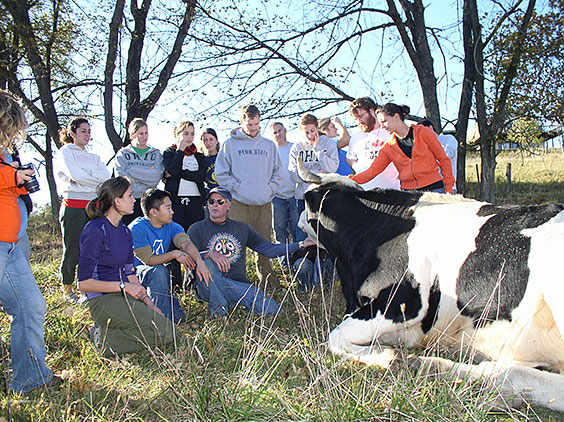- ISCOWP E-newsletters
Blackshirt.construction.BeefXDairy Vegetarians may think they are morally and ethically doing well by not eating meat. It is true ...

Hugs from a cute cow can be more than a cowherd boy can handle! Watch out! The cow Sri Vasanti wants to show her love for cowherd Balaji but forgets he is just a boy. “I’m getting crushed by a cow!” says Balaji. “Cows love affection,” says Balaji as he shows us the “sweet spots” you can rub that will endear you to any cow.
ISCOWP News
Great News! Congratulations everyone! Together we met the $25,000 Matching Gift Challenge early! Thank you again and again! Due to our success, the anonymous Matching Gift donor wants to make another $25,000 challenge good through the end of the year or until we collect the $25,000.00, whichever comes first!
Please consider feeding a cow or cows on this auspicious day of Parama Ekadasi and during this auspicious month of Purusottama Adhika Masa, which ends in a few days. Although the cows are now enjoying pasturing on green pastures, winter is approaching, and we need to buy hay for the ISCOWP herd of 24 cows.

It takes about 200 bales of hay to feed the herd of 24 cows and costs about $9000. Each bale of hay weighs approximately 800 pounds and will feed the ISCOWP herd for one day. One bale costs $45.
$45 to feed the herd of 24 cows for a day
$315 to feed the herd of 24 cows for a week
$1350 to feed the cows for a month
Remember, whatever you give (up to $25,000) will be doubled by our anonymous matching gift donor! Due to the auspiciousness of the next few days, you will also receive increased spiritual benefits by giving in charity to the cows. Please click this link to donate and find out about our gifts to you. And thank you so much!

In honor of ISCOWP’s 30th anniversary, we are posting photos from the past. The photo above was taken in 2007 when we had the ISCOWP farm in West Virginia. Professor Greg Emery from Ohio State University at Athens brought 30 students to ISCOWP to learn about cow protection.
About the Cows

The cow has four stomachs and undergoes a special digestive process to break down the tough and coarse food it eats. When the cow first eats, it chews the food just enough to swallow it. The unchewed food travels to the first two stomachs, the rumen, and the reticulum, where it is stored until later. When the cow is full from this eating process, she rests. Later, the cow coughs up bits of the unchewed food called cud and chews it completely this time before swallowing it again. The cud then goes to the third and fourth stomachs, the omasum and abomasum, where it is fully digested. Some of this digested food enters the bloodstream and travels to a bag called the udder, where it is made into milk that will come out of her teats, while the rest goes towards the cow’s nourishment.
About the Meat and Dairy Industries
“Cows’ acute sense of touch also means that the factory farming conditions in which many of them live cause them considerable pain. Their highly developed tactile sense means that they suffer greatly when they are routinely branded and castrated without pain relief or forced to live in overcrowded feedlots in which they must stand in manure and have no access to pasture or shelter.7 The widespread industry practice of de-horning, or the process of removing the fully-grown horns of adult animals or the horn buds from young animals, also causes profound suffering.8” The Someone Project

7016 SE 92 Terrace
Gainesville, FL 32641 USA
Phone: 352-792-6777
E-mail ISCOWP
Keep up with the latest news from ISCOWP. Sign up with your e-mail address to receive updates.
"*" indicates required fields
© 2023 This is the only official site of The International Society for Cow Protection, Inc. (ISCOWP) incorporated in 1990, located only in Gainesville, FL, USA. ISCOWP and The Lotus/Cow symbol are registered service marks of The International Society for Cow Protection, Inc. Website content can not be reproduced without permission.